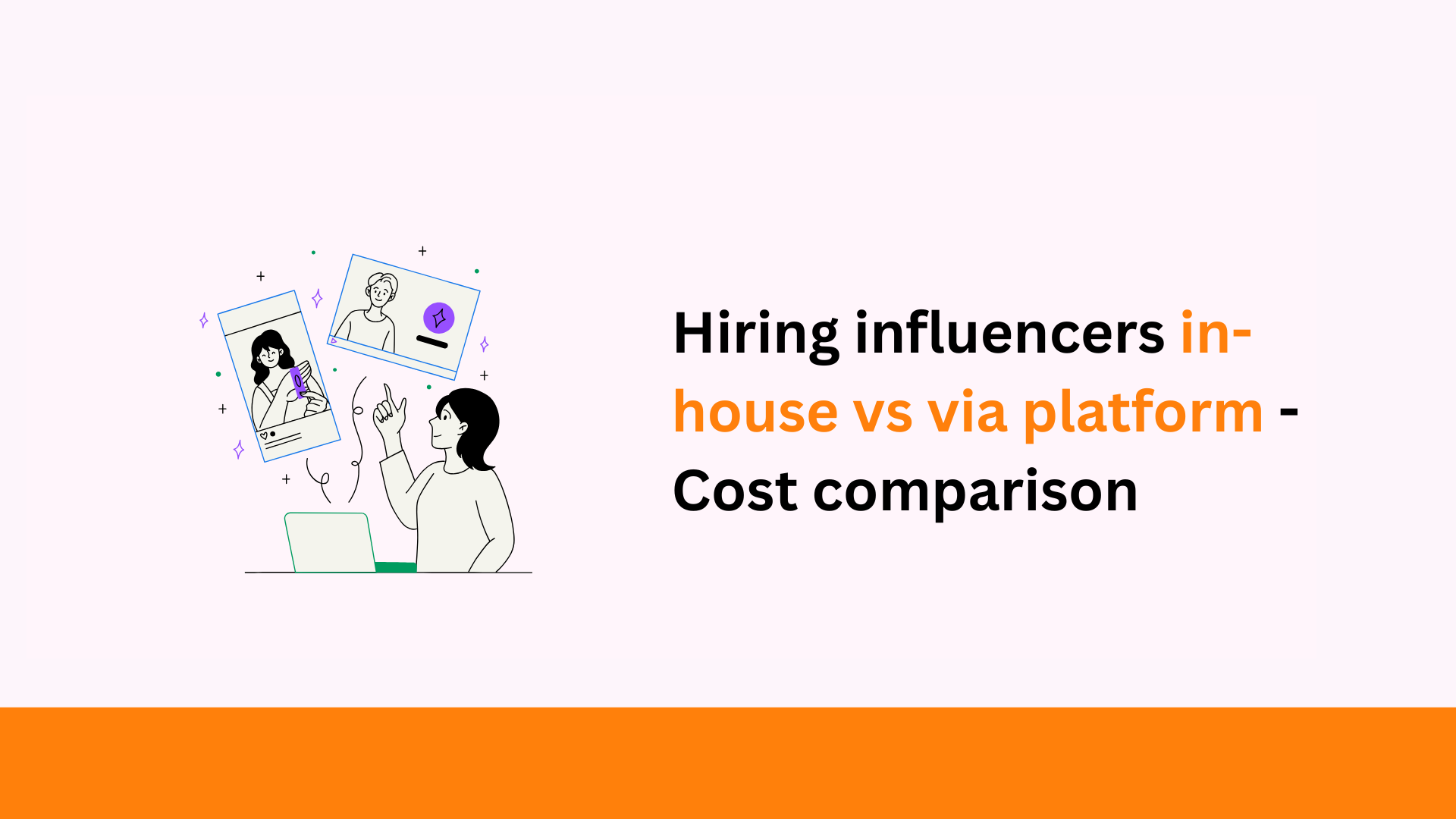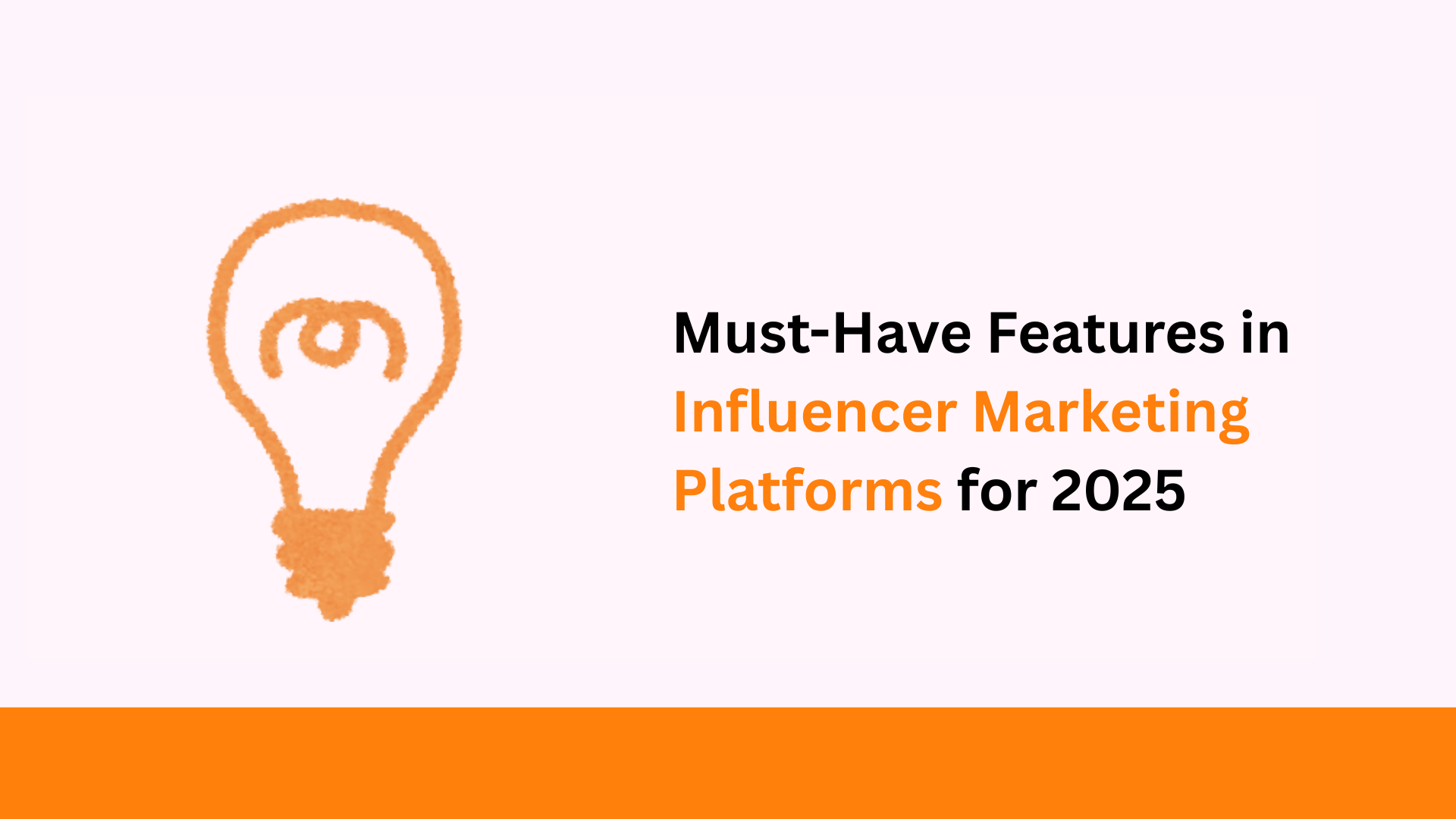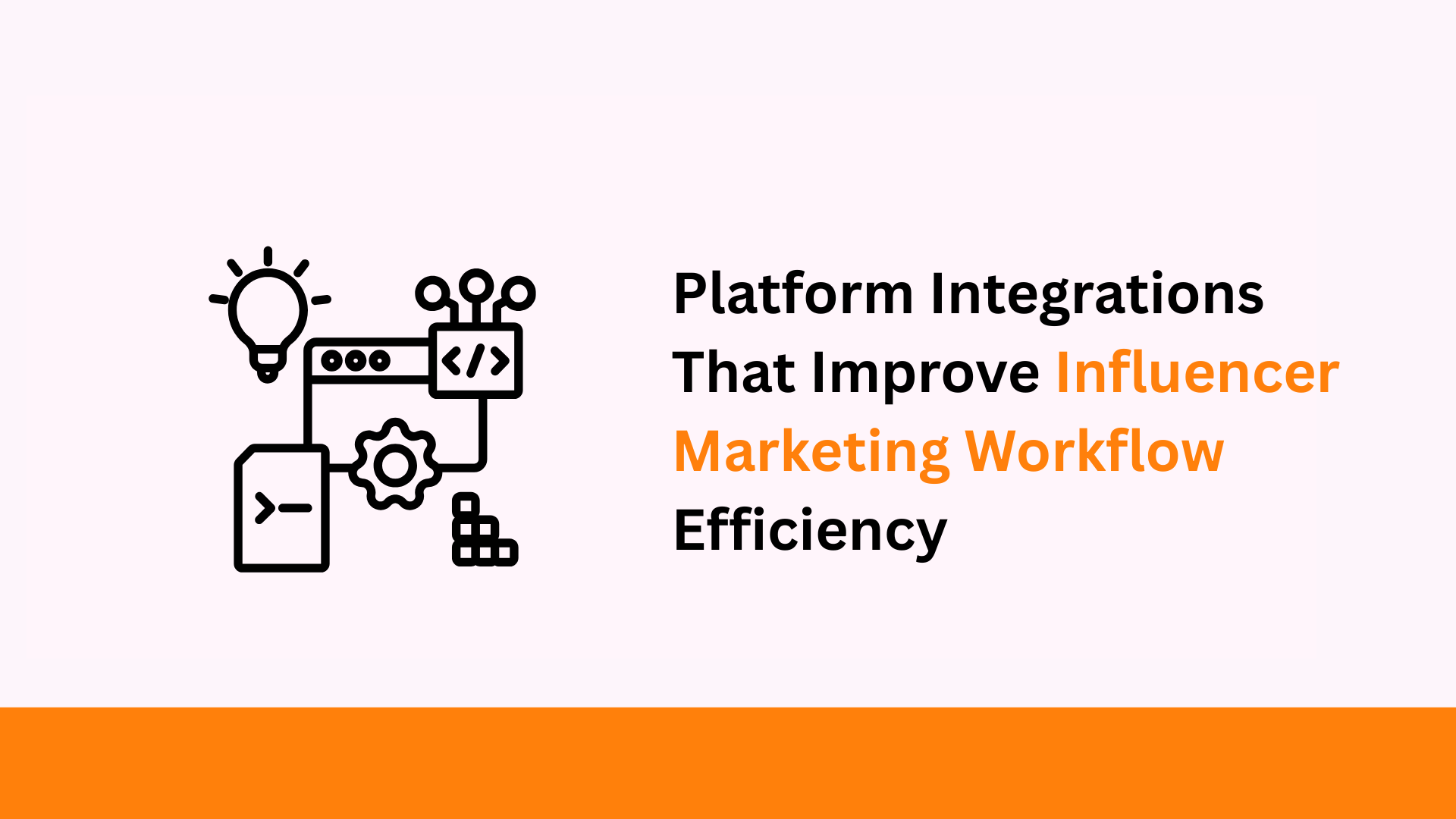TL;DR
- In-house influencer management requires dedicated personnel (₹6-8 lakhs annual salary for mid-level managers) plus additional tools and software
- Platform solutions offer scalability with subscription fees averaging ₹2-7 lakhs monthly
- Platforms reduce influencer discovery time by 70% and campaign setup by 60% compared to manual processes
- Most brands running multiple campaigns yearly see 25-40% better ROI with platforms despite subscription costs
- The right choice depends primarily on your campaign volume, available resources, and long-term strategy
Why choose in-house hiring for influencer campaigns?
76% of brands now include influencer marketing in their strategies, but how you manage these relationships drastically affects your bottom line. In-house management gives you complete control over your influencer relationships and campaigns, which 38% of marketing leaders cite as the primary reason for keeping operations internal.
When managing influencers in-house, your team handles everything: influencer discovery, relationship building, contract negotiation, content approval, and performance tracking. This approach works particularly well for brands with specific requirements and long-term influencer partnerships.
Cost breakdown of in-house influencer management
In-house management requires significant investment in both human resources and technology:
| Expense Category | Typical Annual Cost | Notes |
| Influencer Marketing Manager | ₹6-8 Lakhs | Salary for a mid-level specialist |
| Discovery Tools | ₹1.8-4.5 Lakhs | Basic social listening software |
| Contract Management | ₹90K-2.7 Lakhs | Legal template services or software |
| Performance Tracking | ₹2.7-9 Lakhs | Analytics tools |
| Campaign Management | ₹3.6-5.4 Lakhs | Project management software |
| Total Annual Cost | ₹15-29.6 Lakhs | Before influencer payments |
Looking ahead to next year, brands should consider must-have features in 2025 when evaluating their technology stack for influencer management. The right features can dramatically impact both cost efficiency and campaign effectiveness.
Hidden costs of in-house influencer management
The visible costs only tell part of the story. In-house management comes with significant hidden expenses that often don’t appear in initial budgets:
- Time investment: Your team spends an average of 15-20 hours per week on influencer discovery and vetting for each campaign.
- Relationship maintenance: Building authentic connections requires consistent communication, with marketing teams reporting 5-10 hours weekly on relationship management per 10 active influencers.
- Contract negotiations: Each influencer agreement takes 3-5 hours to negotiate and finalize without standardized systems.
- Content approval cycles: In-house teams spend 30% of campaign time on feedback and revisions.
- Payment processing: Managing invoices and payments adds administrative overhead, with finance teams reporting 2-3 hours per influencer payment.
According to a recent study, Indian marketing teams managing influencers in-house report spending 60% of their time on administrative tasks rather than strategy and optimization.
Fraud prevention represents another significant challenge for in-house teams. Understanding the real ways platforms prevent fraud & boost creator match accuracy helps marketers appreciate the technology investment required to properly vet influencers at scale.
Why use an influencer marketing platform?
Influencer marketing platforms streamline operations through technology, offering comprehensive tools that replace multiple point solutions. These platforms handle the entire workflow from discovery to reporting with automation that reduces manual effort.
Specialized platforms like Qoruz provide databases of pre-vetted influencers, fraud detection tools, and performance analytics that would be prohibitively expensive to develop in-house. This technology enables you to scale campaigns without proportionally increasing staff.
The platform approach particularly benefits brands running multiple campaigns across different product lines or markets. When campaign volume increases, platform efficiency becomes more pronounced, with the cost-per-campaign decreasing as you run more initiatives.
Brands exploring platforms should first research the best influencer marketing platforms in 2024 to understand key differences in features, pricing models, and specializations that might affect their total cost of ownership.
Cost benefits of using influencer marketing platforms
Platforms offer several financial advantages that impact your bottom line:
- Economies of scale: Most platforms use tiered pricing that decreases the per-campaign cost as volume increases.
- Reduced staffing requirements: Companies using platforms report needing 40% fewer dedicated resources for influencer management.
- Improved campaign performance: Algorithmic matching increases engagement rates by an average of 25% compared to manual selection.
- Lower influencer costs: Many platforms offer negotiated rates with influencers, with reported savings of 15-30% on content creation.
- Fraud prevention: Advanced vetting tools reduce wasted spend on fake followers, with platforms claiming to save brands 10-20% on misallocated budgets.
To maximize platform value, marketing teams should understand upcoming innovations and capabilities by reviewing must-have features in 2025 before committing to long-term contracts.
Direct cost comparison: In-house vs platform
When comparing costs directly, consider both the immediate expenses and long-term financial impact:
| Cost Factor | In-House Management | Platform-Based Management |
| Initial Investment | ₹7.5-18.75 Lakhs for tools setup | ₹3.75-7.5 Lakhs for onboarding and training |
| Monthly Operating Cost | ₹4.85-7.15 Lakhs | ₹2.25-7.5 Lakhs platform subscription |
| Team | 3-4 dedicated team members | 1-2 platform manager |
| Time to Launch Campaign | 3-4 weeks | 0-2 weeks |
| Cost per Campaign | Decreases marginally with volume | Decreases significantly with volume |
| Campaign Tracking | Manual tracking, often delayed | Automated real-time analytics |
| Scalability | Linear increase with campaign volume | Same number of resources can be utilised |
According to a 2024 influencer marketing survey in India, brands running fewer than five campaigns annually might find in-house management more cost-effective, while those exceeding this threshold typically see better returns with platforms.
Qoruz has been a game-changer for us at the Titan International Brands department, empowering our team with actionable insights and streamlined campaign management. It has elevated our influencer marketing efforts, allowing us to create meaningful connections and deliver impactful results in the ever-evolving digital landscape,” says Sheetal Mishra, marketing communications manager at Titan Company.
Hidden costs in platform-based campaigns
Platforms aren’t without their own hidden expenses:
- Subscription tiers: Entry-level plans often limit features, with meaningful automation requiring premium tiers.
- Per-campaign fees: Some platforms charge additional fees beyond the base subscription for each active campaign.
- Data export costs: Advanced reporting and data portability sometimes incur extra charges.
- Integration expenses: Connecting platforms to existing marketing tools may require custom development.
- Training requirements: Staff need time to master platform interfaces, with initial productivity drops of 20-30%.
Understanding how platform integrations that improve workflow efficiency work can help brands anticipate these hidden costs and plan accordingly when budgeting for platform adoption.
Key considerations when choosing between in-house and platform solutions
Your decision should factor in more than just immediate costs:
- Campaign Volume: The cost-effectiveness of platforms increases with campaign frequency. If you’re running more than 10 campaigns annually, platforms typically deliver 25-40% better ROI.
- Campaign Complexity: Multi-market campaigns with numerous influencers benefit more from platform automation, with coordination costs reduced by up to 60%.
- Long-Term Strategy: Building in-house expertise makes sense for brands treating influencer marketing as a core competency, while platforms offer flexibility for experimental or seasonal campaigns.
- Brand Control Requirements: Highly regulated industries often prefer in-house management for compliance reasons, though modern platforms increasingly offer compliance features.
- Resource Availability: Companies with existing marketing teams can more easily absorb in-house management, while lean teams benefit from platform efficiencies.
Fraud prevention represents a significant cost consideration that many brands overlook. Understanding real ways platforms prevent fraud & boost creator match accuracy helps marketers appreciate the technology investment required to properly vet influencers at scale.
The Impact of Campaign Frequency on Total Costs
Campaign volume dramatically affects the cost-effectiveness equation. For brands running occasional influencer campaigns, the economics often favor in-house management despite its inefficiencies. However, as campaign frequency increases, platform advantages compound:
For low-volume brands (1-4 campaigns annually):
- In-house management typically costs ₹3.75-7.4 lakhs per campaign
- Platform management costs ₹6.75-22.5 lakhs per campaign
For high-volume brands (12+ campaigns annually):
- In-house management costs ₹1.25-2.47 lakhs per campaign
- Platform management costs ₹0.75-2.25 lakhs per campaign
This inflection point occurs because platform costs are largely fixed, while in-house costs scale more linearly with campaign volume. The more campaigns you run, the more you benefit from platform efficiencies.
The value of time savings
The time dimension often gets overlooked in cost calculations. Consider these research findings:
- In-house teams spend 15-20 hours per influencer discovery and vetting
- Platforms reduce discovery time by 70% through AI-powered matching
- Campaign setup takes 40-60 hours for in-house teams versus 15-25 hours via platforms
- Content approval workflows run 40% faster with platform automation
- Performance reporting takes 5-8 hours manually versus 1-2 hours with platform analytics
These time savings directly translate to labor costs but also affect opportunity costs, what your team could accomplish if not bogged down in administrative tasks.
Technology investment considerations
Building in-house capabilities requires significant technology investments that many brands underestimate:
- Influencer discovery tools: ₹1.8-4.5 lakhs annually for basic social listening and influencer identification
- Relationship management systems: ₹2.7-6.75 lakhs for CRM adaptations specific to influencer management
- Content approval workflows: ₹2.25-4.5 lakhs for dedicated approval systems with version control
- Performance analytics: ₹3.6-9 lakhs for comprehensive measurement tools
- Fraud detection: ₹1.8-5.4 lakhs for tools to identify fake followers and engagement
Platforms bundle these technologies into their subscription costs, offering economies of scale that would be prohibitively expensive for all but the largest brands to develop independently.
Making the right choice for your business
Ultimately, the platform versus in-house decision depends on your specific business context. Consider these guiding questions:
- How many influencer campaigns do you plan to run annually?
- Do you have specialized compliance or control requirements?
- Is your team already stretched thin with existing responsibilities?
- Do you need advanced fraud detection and performance analytics?
- Are you planning to scale your influencer marketing efforts?
The influencer marketing landscape continues evolving rapidly, with platform capabilities expanding while in-house operations become more sophisticated. Your choice ultimately depends on your specific business needs, but understanding the complete cost picture ensures you’re making an informed decision rather than just comparing sticker prices.
For many brands, a hybrid approach proves most effective, starting with in-house management for initial campaigns, then transitioning to platforms as volume increases. This staged approach allows teams to understand their requirements before committing to significant platform investments.
Whether you choose in-house management, platform solutions, or a hybrid approach, regular cost assessment remains crucial. As technology evolves and influencer marketing matures, the financial equations will continue to shift, making flexibility and adaptability your most valuable assets in maximizing ROI.
FAQs
- What are the cost differences between in-house influencer hiring and using a platform?
In-house management requires approximately ₹15-29.6 lakhs annually in staffing and tools before influencer payments, while platforms typically cost ₹27-90 lakhs annually in subscription fees. The breakeven point occurs at approximately 5-7 campaigns annually for most brands.
- What are the hidden costs of managing influencer campaigns in-house?
In-house management incurs significant time costs in influencer discovery (15-20 hours per campaign), relationship maintenance (5-10 hours weekly per 10 influencers), contract negotiations (3-5 hours per agreement), content approvals (30% of campaign time), and payment processing (2-3 hours per influencer).
- How do platforms reduce the costs of influencer marketing?
Platforms reduce costs through automated discovery (saving 70% of search time), standardized contracting (reducing legal reviews by 50%), algorithmic matching (improving engagement by 25%), and integrated analytics (eliminating separate tracking tools). This automation allows teams to manage 3x more campaigns with the same resources.



